Inventory management sits at the heart of every successful business. It balances supply and demand, ensuring products are available when customers need them without tying up unnecessary capital. When managed well, it protects cash flow, minimizes waste, and builds the reliability that keeps customers coming back.
Yet many organizations still rely on disconnected spreadsheets and manual updates that make it difficult to spot trends or respond quickly to changes in demand. The result is often the same: excess stock gathering dust or sudden shortages that disrupt operations.
Modern inventory management takes a more connected approach. By combining real-time data, demand forecasting, and automated workflows, it gives teams the visibility and control needed to operate efficiently. From proven methods like JIT and ABC analysis to digital templates that simplify daily processes, this guide explores how businesses can turn inventory into a strategic advantage rather than a constant challenge.
Key takeaways
- Optimize cash flow and customer satisfaction: effective inventory management balances availability with efficiency, keeping stock levels healthy without locking up cash in excess inventory.
- Choose methods that fit your operations: retailers often rely on ABC analysis to prioritize products, while manufacturers use just-in-time (JIT) systems to reduce storage costs and waste.
- Turn data into action with monday work management: the platform centralizes inventory tracking, automates key workflows, and provides AI-powered insights with real-time visibility to support scalable growth.
- Build a strong foundation: begin with a full inventory audit, implement reliable tracking tools, and set reorder points based on demand trends and supplier lead times.
- Modernize your approach: advanced inventory systems replace manual spreadsheets with automated alerts, analytics, and error-free reporting for smarter purchasing decisions.
What is inventory management?
Inventory management is the process of ordering, storing, tracking, and controlling your company’s stock. It involves knowing exactly what products you have, where they’re located, and when to reorder, all while keeping costs under control.
It serves as the backbone of business operations, connecting every stage from raw materials to finished goods. Effective management ensures that the right products are always available at the right time, keeping both production and customer satisfaction running smoothly.
Understanding inventory management systems
An inventory management system is inventory management software that automates how you track and control stock levels. These management systems replace manual spreadsheets with real-time data that updates automatically as products move through your business.
Modern systems connect to barcode scanners, point-of-sale systems, and supplier databases. They send alerts when stock runs low and can even create purchase orders automatically.
Inventory management vs inventory control
While the two terms are often used interchangeably, they focus on different levels of operation. Inventory management is the strategic process of planning what to stock, how much to order, and when to replenish to meet demand without overspending. It’s about forecasting, setting policies, and maintaining a healthy balance between availability and cost.
Inventory control, on the other hand, focuses on execution. It’s the hands-on process of tracking stock movement, monitoring quality, and ensuring items are stored and distributed accurately. Where management sets the direction, control keeps everything running smoothly day to day.
Together, they create a complete system — management defines the plan, and control ensures it’s carried out effectively.
Inventory management vs supply chain management
Supply chain management covers everything from raw material suppliers to final customer delivery. Inventory management is just one piece of this larger puzzle.
While supply chain management coordinates relationships with vendors and shipping partners, inventory management focuses specifically on the stock within your walls. Both work together, but inventory management deals with what you own and control directly.
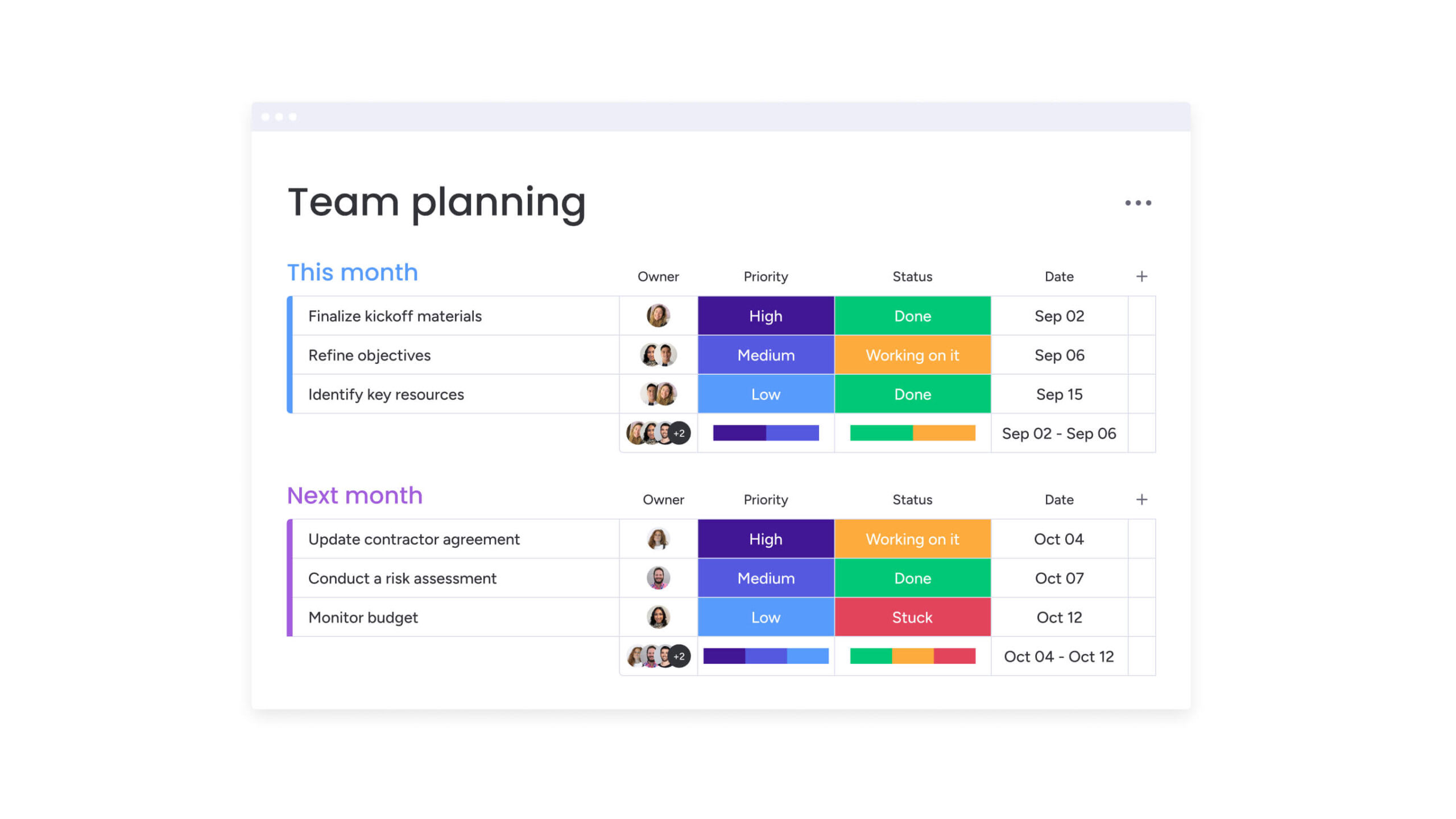
How does inventory management work?
Inventory management follows a continuous cycle. You forecast demand, place orders, receive products, store them properly, sell to customers, then start again. Each step feeds into the next.
The process starts with analyzing sales data to predict what customers will buy. Based on these forecasts, procurement management ensures you order from suppliers at the right time to avoid stockouts or excess inventory.
Core components of inventory management
Every inventory system relies on five essential elements working together to create a seamless flow from procurement to sale. Understanding each component helps you build a system that actually works for your business, giving you control over costs and customer satisfaction. These core components are:
- Demand forecasting: predicting what customers will buy based on past sales and market trends.
- Procurement: ordering the right products at the right time from reliable suppliers.
- Storage: organizing products so you can find them quickly and keep them in good condition
- Tracking: monitoring stock levels and movement through your business.
- Reporting: analyzing performance to spot problems and opportunities.
The inventory management process flow
An effective inventory process keeps products moving seamlessly from purchase to delivery. It starts when stock levels reach a predefined reorder point — the signal that it’s time to restock. At that stage, your order management system automatically generates and sends a purchase order to suppliers, ensuring replenishment happens before shortages occur.
Once the new inventory arrives, it’s checked for quality, recorded in your system, and made available for sale or production. As items are used or sold, your system updates stock counts in real time, maintaining accurate visibility across the supply chain. This continuous cycle forms the backbone of efficient inventory operations, preventing both overstocking and stockouts.
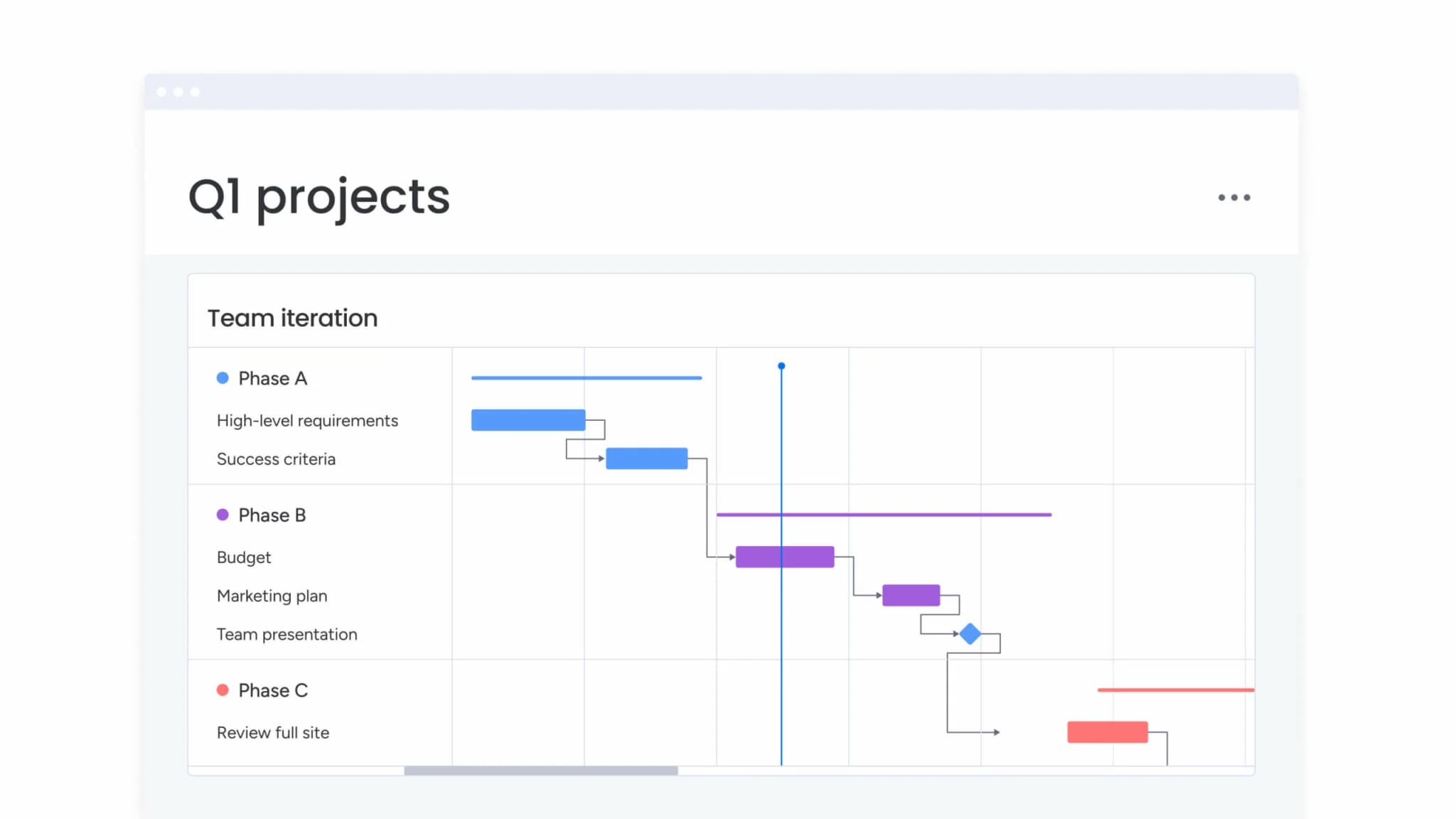
How inventory management drives business success
Inefficient inventory practices can quickly drain resources and damage customer relationships. Too much stock ties up valuable cash, while too little leads to missed sales and frustrated buyers. Effective inventory management prevents both problems, keeping products available while maintaining financial flexibility, which is essential for strong operations management.
Platforms like monday work management make this balance easier to achieve by connecting inventory data with automated workflows and real-time insights. Together, these capabilities help teams:
- Track stock levels and reorder points automatically.
- Reduce waste by aligning purchases with real demand.
- Gain instant visibility into inventory performance across locations.
- Free up working capital to invest in growth.
By transforming inventory into a connected, data-driven process, businesses can boost efficiency, customer satisfaction, and long-term profitability.
Optimize cash flow and working capital
Every dollar sitting in unsold inventory is a dollar you can’t invest elsewhere. In fact, research shows that excess inventory has led to approximately $707 billion of trapped liquidity in working capital across industries.
Effective inventory management minimizes this trapped capital while maintaining enough stock to meet demand.
Maximize customer satisfaction
Nothing frustrates customers more than finding their desired product out of stock. Good inventory management prevents these disappointments by maintaining optimal stock levels.
When products are consistently available, customers trust your business. They return more often and recommend you to others, driving sustainable growth.
Minimize storage costs and waste
Storage isn’t free. You pay for warehouse space, insurance, utilities, and staff to manage it all. cost management helps you keep these carrying costs from adding up.
Smart inventory management, combined with warehouse software, reduces these expenses by keeping stock levels lean. You also minimize losses from expired products, damage, or items becoming obsolete.
Enable smarter business decisions
Real-time inventory data reveals which products generate profits and which drain resources. You can spot trends early and adjust your strategy before problems grow.
This visibility helps you negotiate with suppliers, plan promotions around available stock, and identify opportunities to streamline operations.
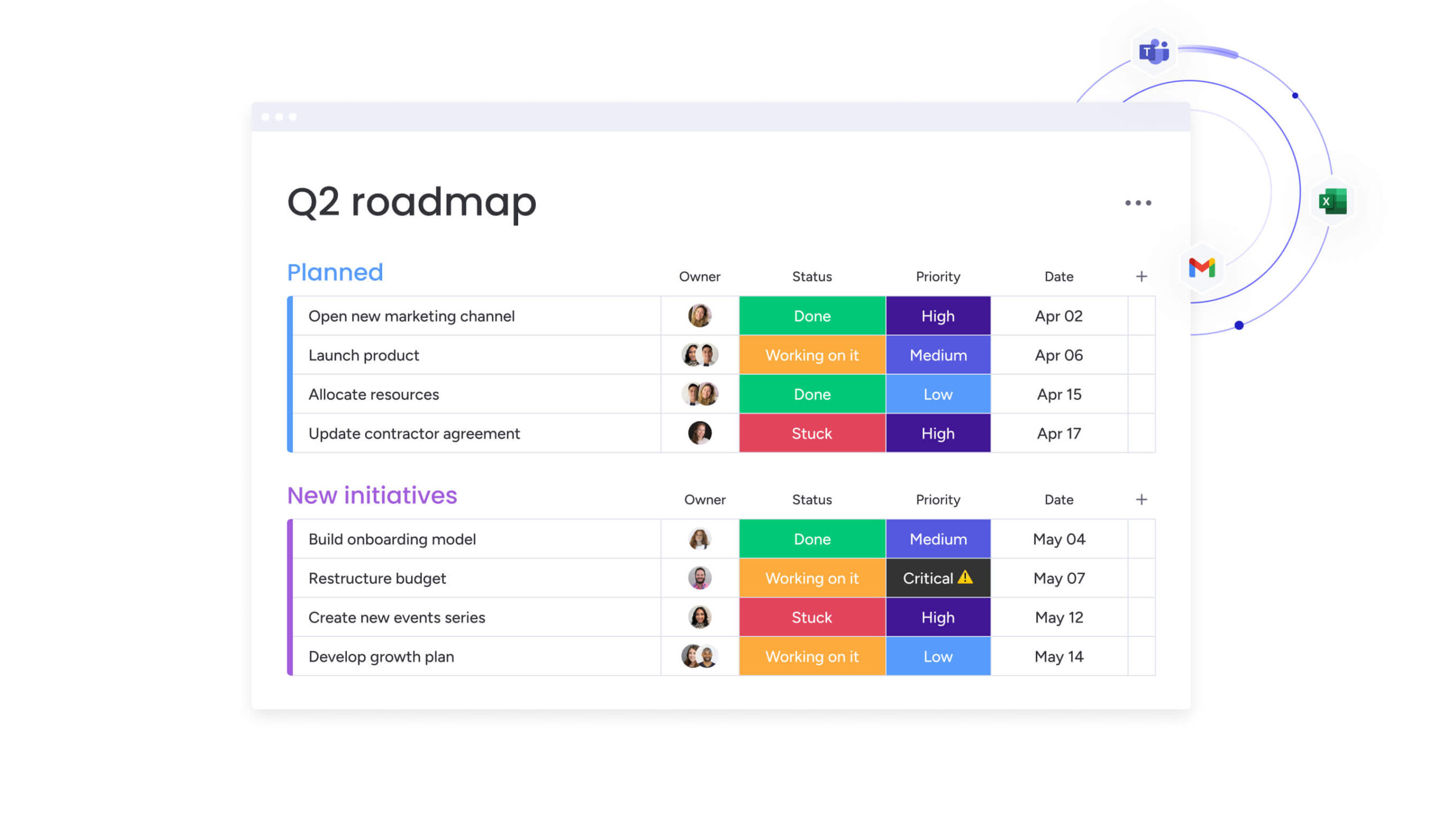
7 proven inventory management methods
There’s no single way to manage inventory effectively: the right approach depends on what you sell, how you operate, and how predictable your demand is. Successful businesses often combine several techniques to balance efficiency, cost control, and customer satisfaction.
Below are seven proven inventory management methods that help teams streamline operations, minimize waste, and maintain the perfect stock balance.
1. Just-in-time (JIT) inventory
JIT means receiving inventory only when you need it for production or sale. This approach minimizes storage costs and reduces waste from unsold products.
Success with JIT requires reliable suppliers and accurate demand forecasting. Manufacturing companies often use this method to keep work-in-progress inventory low.
2. Economic order quantity (EOQ)
EOQ calculates the ideal order size by balancing ordering costs against storage costs. Order too often and you waste money on shipping. Order too much and storage costs eat your profits.
This mathematical approach provides a starting point, though most businesses adjust based on supplier minimums and cash flow needs.
3. ABC inventory analysis
ABC analysis ranks products by importance. Your “A” items generate most revenue and need closest monitoring. “C” items matter less and can use simpler tracking.
This prioritization ensures you focus effort where it creates the most value. Why spend equal time managing paper clips and your bestselling products?
4. First in first out (FIFO)
FIFO ensures older inventory sells before newer stock. This prevents spoilage in perishable goods and reduces obsolescence in all products.
Beyond operational benefits, FIFO often provides tax advantages by matching older, lower-cost inventory against current sales prices.
5. Materials requirement planning (MRP)
MRP works backward from production schedule to determine when to order materials. If you need 100 finished products next month, MRP calculates exactly what components to order today.
This method excels in manufacturing where multiple components must arrive together for assembly.
6. Safety stock strategy
Safety stock acts as insurance against unexpected demand or supplier delays. You keep extra inventory to prevent stockouts when things don’t go as planned.
The trick is finding the right balance. Too much safety stock wastes money. Too little risks disappointing customers.
7. Demand forecasting techniques
Accurate forecasting forms the foundation for all other methods. Common approaches include analyzing historical sales, tracking seasonal patterns, and monitoring market trends — core elements of demand management.
Advanced forecasting might incorporate weather data, economic indicators, or social media buzz to predict demand more accurately.
Inventory management systems that scale
As businesses expand, managing inventory manually becomes time-consuming and error-prone. Spreadsheets that once worked for a small operation can’t keep up with multiple sales channels, warehouses, and fast-moving demand. Modern inventory management systems solve this challenge by automating routine tasks and delivering real-time insights that help teams make smarter, faster decisions.
Below are the essential features to look for in a system that can grow with your business while keeping operations efficient and customers satisfied.
Essential features of modern inventory systems
- Real-time visibility: see current stock levels across all locations instantly.
- Automated reordering: generate purchase orders when inventory drops below set points.
- Multi-channel integration: sync inventory across your website, store, and marketplaces.
- Barcode scanning: update stock levels instantly with mobile devices.
- Performance analytics: track turnover rates, carrying costs, and profitability by product.
How inventory management software transforms operations
Software eliminates hours of manual counting and data entry. Teams can focus on strategic decisions instead of updating spreadsheets by using resource management software.
Automation handles routine tasks like reorder alerts and stock transfers. This shift from reactive to proactive management prevents problems before they impact customers.
Choosing the right system for your business
System selection depends on your specific needs. Consider your product variety, number of locations, integration requirements, and growth plans.
Start with must-have features, then evaluate ease of use and total cost. The best system balances functionality with simplicity to ensure your team actually uses it, a crucial point given that research shows only 71% of employees report actually using the work management software provided at the largest enterprise companies.
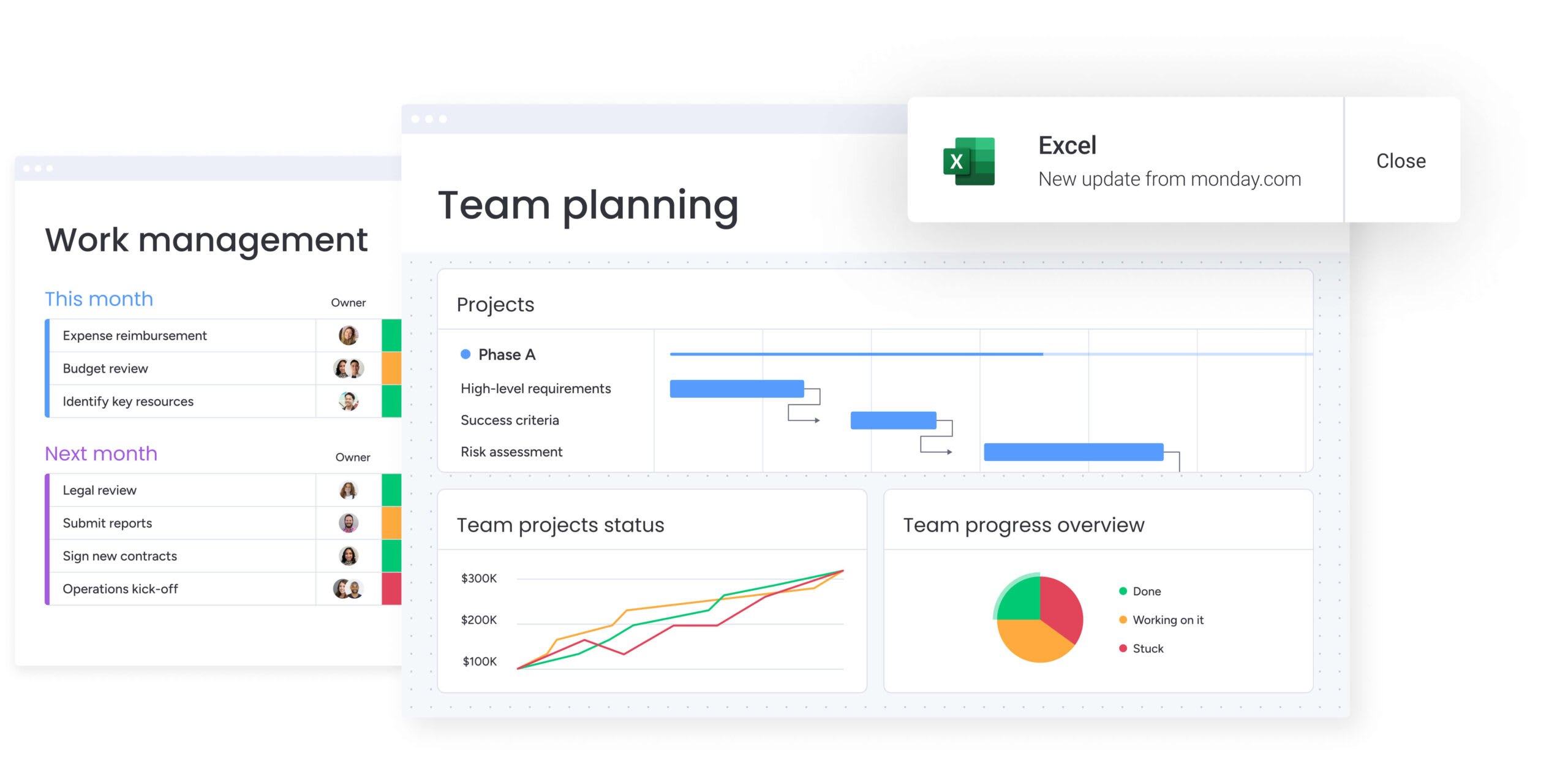
5 steps to implement inventory management
Step 1: audit your current inventory
Start with a complete physical count. Document every item’s quantity, condition, and location. This baseline reveals the gap between what you think you have and reality.
Note damaged goods, misplaced items, and obsolete stock. This information guides immediate improvements and helps measure future progress.
Step 2: select your management method
Choose an approach that fits your business model and resources. Retailers might combine ABC analysis with FIFO. Manufacturers often use MRP with safety stock buffers.
Start simple and add complexity gradually. Your method should support your business, not complicate it.
Step 3: deploy tracking technology
Implement systems that match your volume and accuracy needs. Small businesses might start with basic barcode scanning. Larger operations may need RFID tracking or automated systems.
Test new technology in limited areas first. This minimizes disruption while you refine processes and train staff.
Step 4: calculate reorder points
Set reorder points using average daily usage, supplier lead times, and safety stock needs. When inventory hits these triggers, it’s time to order more.
Review these calculations regularly. Demand patterns change, and your reorder points should adjust accordingly.
Step 5: measure and refine performance
Track metrics like inventory turnover, stockout frequency, and carrying costs, as this clarity helps employees understand how success is measured (making them twice more likely to feel motivated). These numbers reveal what’s working and what needs adjustment.
Create feedback loops with your team. Their daily experience provides insights that numbers alone might miss.
Inventory management examples across industries
Every industry faces its own inventory challenges, from retailers managing fast-changing trends to manufacturers balancing supply chains and e-commerce businesses racing to meet delivery expectations. The principles of great inventory management stay the same, but the methods vary depending on what’s being tracked and how customers buy.
Below are real-world examples of how different industries apply inventory management practices to stay efficient, reduce waste, and keep operations running smoothly.
Retail inventory excellence
Retailers juggle thousands of products while managing seasonal demand and changing trends. store management software helps them use sophisticated forecasting that incorporates weather patterns, local events, and social media trends.
Successful retailers maintain minimal stock while using real-time data to identify winners quickly. They can reorder hot items before stockouts disappoint customers.
Manufacturing inventory optimization
Manufacturers coordinate raw materials, components, and finished goods across complex supply chains. They balance holding costs against production shutdown risks.
Just-in-time delivery reduces inventory investment but requires reliable suppliers. Many manufacturers rely on production management software to combine JIT efficiency with safety stock for critical components.
E-commerce inventory strategies
E-commerce businesses face the challenge of balancing fast delivery times with accurate stock management across multiple channels. Success depends on maintaining visibility and flexibility at every stage of fulfillment.
Key practices include:
- Multi-channel synchronization: keep inventory data consistent across your website, marketplaces, and retail partners.
- Distributed inventory: store products in multiple locations based on regional demand to reduce shipping costs and delivery times.
- Real-time tracking: use connected systems to monitor stock movement and prevent overselling or backorders.
This approach helps online sellers meet customer expectations while keeping operations lean and responsive.
Service industry inventory solutions
Service-based businesses manage supplies and equipment rather than sellable products, requiring a different approach to tracking and replenishment. Hotels, restaurants, and healthcare providers all depend on precision and efficiency.
Effective strategies include:
- Usage-based tracking: monitor consumption patterns to forecast future supply needs accurately.
- Waste reduction: implement systems that flag overuse or spoilage before it affects margins.
- Stock balance optimization: maintain enough supplies to meet demand without tying up capital in excess inventory.
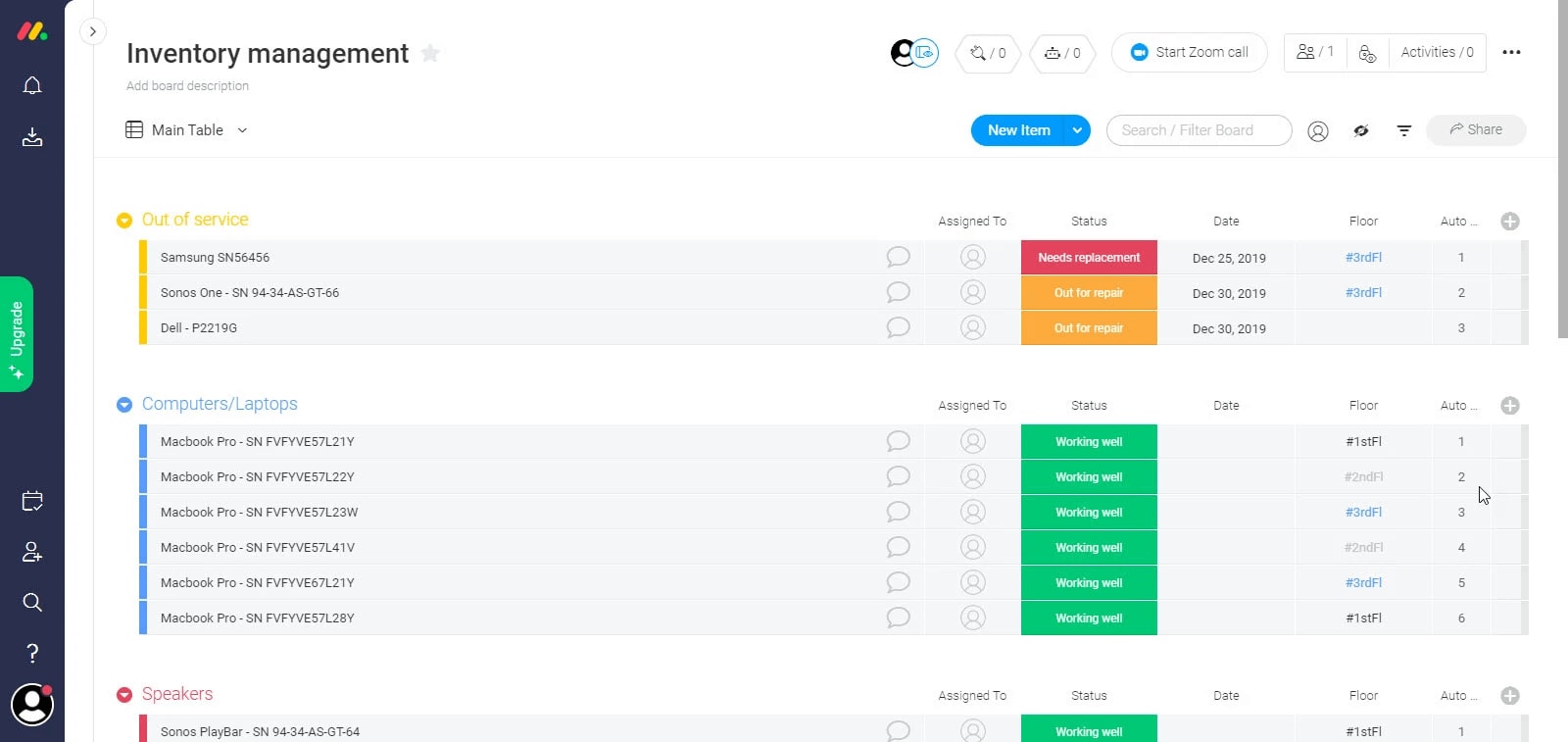
Ready-to-use inventory management templates
Building an efficient inventory process takes more than good intentions — it requires structure, consistency, and the right tools. Templates provide a proven foundation, helping teams standardize tracking, automate reorders, and monitor performance without starting from scratch.
Modern platforms like monday work management make these templates fully interactive, turning static spreadsheets into connected, automated systems. They allow businesses to customize workflows, visualize stock levels in real time, and scale effortlessly as operations grow.
Here are a few ready-to-use inventory management templates that simplify setup and help teams manage inventory with greater accuracy and control.
Inventory tracking dashboard template
This template centralizes all inventory data in one visual dashboard. See stock levels, pending orders, and key metrics at a glance.
Automated calculations show inventory turnover and days of supply. Color-coded alerts highlight items needing attention immediately.
Automated reorder point template
Calculate optimal reorder points based on your specific lead times and demand patterns. The template automatically flags items approaching reorder thresholds.
Built-in formulas adjust for seasonality and growth trends. Integration with supplier systems can trigger purchase orders automatically.
ABC analysis framework template
Categorize inventory by value and velocity using this structured framework. The template assigns items to categories based on your criteria.
Regular reviews keep categories current as your business evolves. Different management rules apply to each category for maximum efficiency.
Inventory audit checklist template
Ensure accurate counts with this comprehensive audit guide. The checklist covers pre-count preparation, counting procedures, and reconciliation steps.
Built-in variance tracking helps identify problem areas. Documentation features create an audit trail for compliance and continuous improvement.
Streamline inventory management with monday work management
Managing inventory across multiple locations, suppliers, and sales channels quickly becomes complex — especially when relying on disconnected spreadsheets. Modern work management platforms bring everything together, turning fragmented tracking into coordinated, real-time visibility that supports smarter decisions and faster action.
With capabilities for automation, collaboration, and integrated reporting, monday work management provides the structure needed to simplify inventory control at scale. It connects every process — from demand forecasting to supplier coordination — so teams can operate from a single source of truth while automation handles repetitive tasks.
Automate inventory workflows with AI blocks
AI blocks in monday work management eliminate manual data entry and analysis. Research shows that embedding AI in operations can create significant value, including reductions of 20% to 30% in inventory. You can extract key information from supplier documents instantly and categorize products automatically based on your rules.
Real-time inventory visibility across teams
Everyone sees the same live data through customizable dashboards. Sales knows what’s available before making promises. Purchasing sees what’s running low before stockouts occur.
Automated alerts keep teams informed without constant checking. Set triggers for low stock, delayed shipments, or any condition that needs attention.
Integrate your existing inventory platforms
Connect monday work management with your current systems instead of replacing them. Popular integrations include QuickBooks, Shopify, and major supplier portals.
Data flows automatically between platforms, eliminating duplicate entry. Your team works in familiar systems while gaining powerful new capabilities.
Scale from simple tracking to enterprise management
Start with basic templates and add features as you grow. Small businesses begin with stock tracking and reorder alerts. Larger operations add approval workflows, multi-currency support, and advanced analytics.
The platform adapts to your changing needs without forcing system changes. What works for 10 products scales smoothly to 10,000.
Frequently asked questions
What are the four types of inventory in business?
The four types of inventory in business are raw materials (components used to create products), work-in-progress (partially completed items in production), finished goods (completed products ready for sale), and maintenance, repair, and operations supplies (MRO items that support operations but aren't sold).
How do you calculate inventory turnover ratio?
The inventory turnover ratio is calculated by dividing the cost of goods sold by the average inventory value over a given period. For instance, a ratio of six indicates that a company sold and replaced its entire inventory six times during the year.
What is the 80/20 rule for inventory management?
The 80/20 rule for inventory management states that 80% of your sales typically come from 20% of your products. This principle helps you identify which items deserve the most attention and resources in your inventory system.
How often should businesses perform inventory audits?
Businesses should perform complete physical inventory counts annually, with partial cycle counts monthly or quarterly based on product value and turnover speed. High-value or fast-moving items need more frequent counts to maintain accuracy.
What causes inventory shrinkage in businesses?
Inventory shrinkage in businesses happens due to employee theft, shoplifting, administrative errors, supplier fraud, and damage during storage or handling. Regular audits and proper security measures help identify and reduce these losses.
Do small businesses need inventory management software?
Small businesses need inventory management software when manual tracking becomes time-consuming, error-prone, or limits growth. Even basic software prevents expensive stockouts and overstock situations while providing insights for smarter purchasing decisions.
 Get started
Get started


